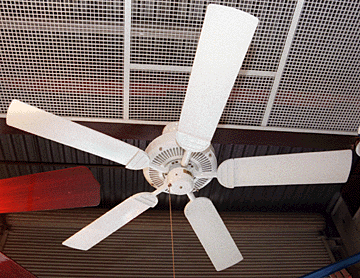
Fan Shop president Richard Galope displays the different fan blade types and colors available at his store. Photo by Dennis Oda, Star-Bulletin

Fan Shop president Richard Galope displays the different fan blade types and colors available at his store. Photo by Dennis Oda, Star-Bulletin
Here in the summer of 1996, with temperatures approaching the same number as the year, ceiling fans are more popular than ever, and sales are surging, according to local merchants. There was a period in the 1960s when ceiling fan sales dropped as air conditioners became a household item, but fans made a serious comeback in the 1970s during the energy crisis.
A ceiling fan generally uses less current than a light bulb, and cools the immediate area an average of eight degrees. When used in conjunction with an air conditioner, both can be used on minimum settings for a maximum of energy efficiency.
Beyond their usefulness, ceiling fans became a design element in many homes and businesses, bringing to mind the tropical ambience of the movie "Casablanca." One major manufacturer even uses that name.
"The Hunter name is best-known, because they've been in business since the beginning," said Monte Hammond of The Fan Shop.
"Hunter is almost synonymous with ceiling fans, but others like Casablanca and Emerson are just as good," said Michael Brooks, general manager of Fan & Light Factory. "All offer differing styles and features."
Almost all fans sold are white, although designer models use a variety of colored and metallic finishes. "There's a trend toward antique finishes," said Hammond.
And you get what you pay for.
"You can expect to spend about $150 for a decent-quality fan, with a life of at least 15 years," said Hammond.
Blade balance is critical, and blades must weigh within a gram of each other for the fan to spin successfully. If cheap blades become blunted with humidity and dust, they wobble and rattle and become less efficient. Unfortunately, there are no standards for blade-mounting in the industry, and one manufacturer's blades will not fit another. This can cause problems in replacing blades.
Fan Shop president Richard Galope suggests that when shopping for fans, buyers check out the width of the fan stem, the metal part that attaches the blade to the motor. "Make sure the fan stem is three-quarters of an inch thick," said Galope. "That's the best single indication of quality. If it's a half-inch stem, you're more likely to run into problems" from the part breaking or warping.

The Sierra Rain Fan was specifically designed for Hawaii's conditions. Photo by Craig Kojima, Star-Bulletin
"You've got to have powder-paint finishes baked on, and stainless steel fastenings, and high-impact plastic ABS blades to survive," said Scanlan. (He also said that his Rain Fan model is the only model ceiling fan approved by the state.
"Generally, you have no problem with six-ply wooden blades from the name manufacturers," said Brooks. "It's the cheapie fans from the discount houses where the blades fall apart in Hawaii."
Brooks added that discount fans have open-faced bearings, which eventually allow dust to build up in the works and make the fan noisy. A brand-name fan is nearly silent.
"The cheap fans also have low angles on their blades, which means that, through you can see the blades turning like crazy, they're not moving much air."
Brooks said they get 15 to 20 calls a day looking for replacement parts. No problem for brand-name fans, but impossible for many cheap fans.
"Unfortunately, a lifetime warranty doesn't mean much if the company goes out of business," Brooks said.